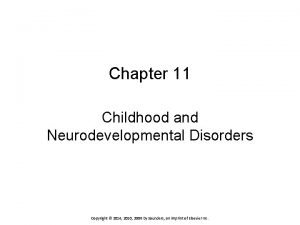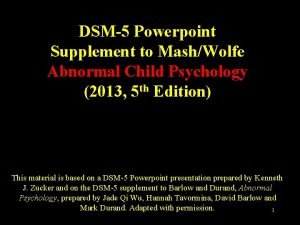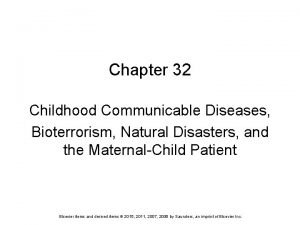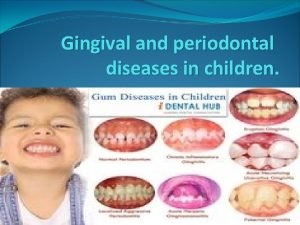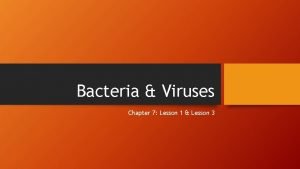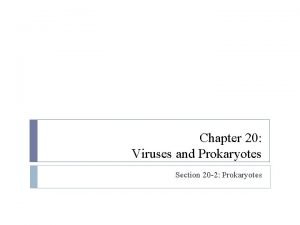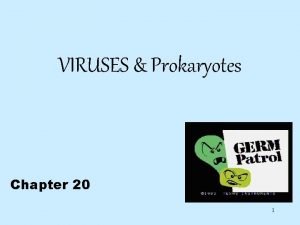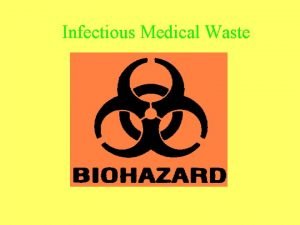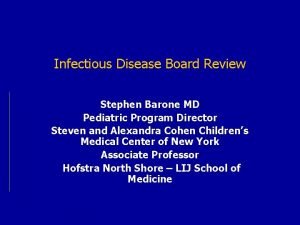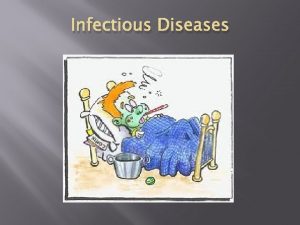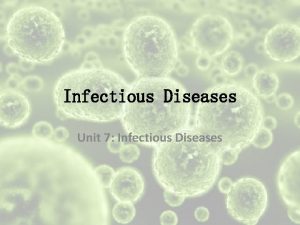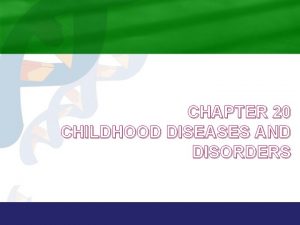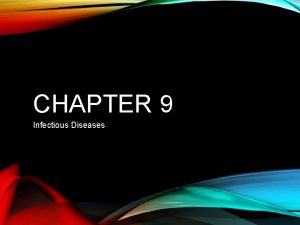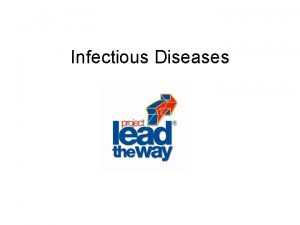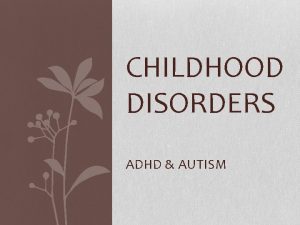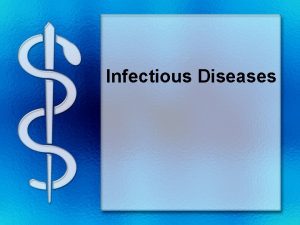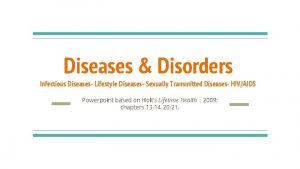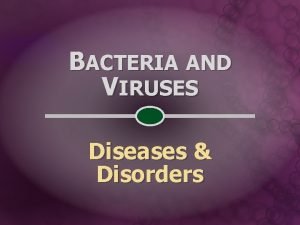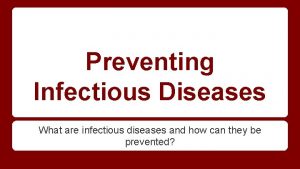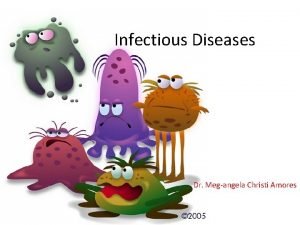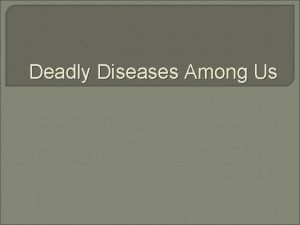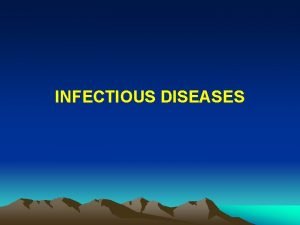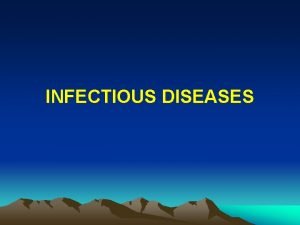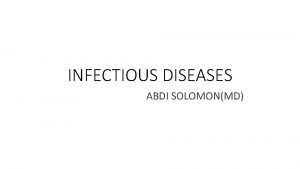Childhood Diseases and Disorders Pathophysiology Infectious Diseases Viruses





































- Slides: 37

Childhood Diseases and Disorders Pathophysiology

Infectious Diseases § Viruses § Bacterial § Fungal § Parasitic

Viral Diseases

Measles, Mumps, and Rubella (MMR) § § § Measles (Rubeola) § Highly contagious (incubation period is 7 -14 days) § Symptoms include fever, inflammation of respiratory mucous membranes, rash, and spots in mouth called Koplik’s spots § Treatment is fluids, fever reducer, and rest § May cause encephalitis or meningitis or ear infections and conjunctivitis (pink eye) Mumps § Affects parotid glands (one of the three salivary glands) § Spread by saliva with incubation period 16 -18 but may be as long as 25 days § Blood test determines presence and symptoms are chills, swelling of glands, fever § Treatment is to treat symptoms § May cause orchitis (inflammation of testis) or nerve conduction deafness Rubella (German Measles or three day measles) § Incubation period of 14 -21 days § Symptoms like rubeola but lighter in color; also joint pain and lymph node involvement § Diagnosis through a blood test § May cause fetal problems or birth defects is pregnant women are exposed (80% chance in first 3 mos)

MMR

Varicella (Chicken Pox)/ Poliomyelitis § § Varicella § Incubation of 10 -21 days; caused by varicella-zoster § May have shingles as an adult § Symptoms include classic dew drop rose petal macular rash (vesicles) Poliomyelitis § Incubation of 3 -6 days for milder form, 7 -21 for severe form § Spread through oral fecal routes § Headache, sore throat and then paralysis § Stool sample or throat cultures confirms diagnosis § Treatment is only supportive; physical therapy or respiratory ventilation may be needed

Chicken Pox Polio

Influenza/ Common Cold § § Influenza § Symptoms are fever, headache, joint pain, runny nose, etc § No treatment except rest, hydration, nasal sprays Common Cold (rhinovirus) § Symptoms are rhinitis § No treatment except rest, hydration, nasal sprays

Mononucleosis § Caused by Epstein-Barr virus § Spread through saliva § Symptoms happen 4 -7 days after exposure § Diagnosis through blood test showing rise in WBC § Takes 3 -4 weeks to recover and sports should be avoided for one month after to protect the spleen

Acquired Immunodeficiency Syndrome (AIDS) § Caused by HIV virus § In 1980’s most children with the disease got it from infected blood because they were hemophiliacs and received transfusions. Today most get it from perinatal transmission § Some sexually active teens have the disease § 2. 1 million live with HIV § Time between HIV infection and AIDS is shorter in children and infants

Bacterial Diseases

Diphtheria / Pertussis § § Diphtheria § Once had a fatality rate of 20% in 1920’s § Caused by Corynebacterium diphtheriae § Produces a membranous coating of pharynx, nose, and sometimes tracheobronchial tree called exudate with proteins and WBC that seep from tissue § Diagnosis is gray membrane covering throat and positive culture § Treatment is antibiotic and diphtheria antitoxin Pertussis (whooping cough) § Caused by Bordetella pertussis § Incubation is 6 -10 days but can be as long as 21 days § Symptoms are § § Catarrhal- increase in inflammation of mucous membranes § Paroxysmal-spasm or convulsion with violent coughing, cyanosis, vomiting § Convalescent stage-gradually reduced coughing Treatment is with antibiotics and supportive therapy but pneumonia can be a problem

Tuberculosis (TB) § Affects respiratory system § Currently on the rise § Caused by Mycobacterium tuberculosis § Also found in GI system and the bones, brain, and lymph nodes § Incubation period is 4 -12 weeks § Symptoms include bloody sputum, fever, cough, lymph node enlargement § Disease in children often stays dormant § Diagnosis is by positive skin test, sputum culture and chest x-rays § Treatment is rest, drug therapy § There is a TB vaccine, bacille Calmette-Guesnn per year (BCG) for places with infection greater than 1%

Tularemia (Rabbit fever or deer fly fever) § Caused by Francisella tularensis § Symptoms include headaches, lymph node swelling, chills, vomiting § Diagnosis is with blood test or chest x-ray to rule our pneumonia § Treatment is with antibiotics § Prevention is protection from ticks

Impetigo / Acute Tonsillitis / Otitis Media § § § Impetigo § Caused by pyoderma commonly found on face and hands of children § Caused by Staphylococcus aureus Acute Tonsillitis § Infection of palatine tonsils caused by beta-hemolytic streptococci § Symptoms are sore throat, cough, fever, trouble swallowing § Diagnosis with throat culture § Treatment is tonsillectomy Otitis Media § Bacterial infection of middle ear § If persistent, myringotomy with tympanopathy tubes might be treatment

Fungal Diseases

Candidiasis/ Tinea § § Candidiasis § Also known as thrush, oral fungal infection § Caused by Candida albicans § White plaques on mucous membranes and tongue § Treatment of choice is usually swabbing mouth with oral nystatin Tinea § Also known as ringworm § Usually affect scalp and between toes § Males also get it in the groin area

Parasitic Diseases

Giardiasis / Pediculosis § Giardiasis § § § § Infection with protozoa called giardia Caused by the Giardia lamblia and affects the digestive system Symptoms include watery diarrhea , nausea, flatulence Stool will float and be shiny May take many samples to identify parasite Treatment is furazolidone or similar drugs; clear fluids to prevent dehydration Pediculosis Lice acceptance § Adult females produce 6 eggs/ 24 hours § Nits (eggs) can be seen in hair § Treated with permethrin 1% crème rinse §

Pinworms/ Roundworms § Pinworms (seatworms or threadworms) are nematodes that infect intestines and rectum § § § § No harmful, just itchy Caused by Enterobius vermicularis Eggs can survive for 2 -3 weeks; females lay 10, 000 -20, 000 eggs at anus Symptoms are anal itching and look like white threads Diagnosis is by microscopic exam of stool Treatment is OTC or prescription drug therapy; may need to repeat in 2 weeks Roundworms § Ascaris lumbricoides found in soil Symptoms are abdominal pain, excessive gas, weight loss, vomiting § Diagnosis is through stool sample § Treatment is same as for pinworms §

Respiratory Diseases § SIDS § Croup § Adenopid Hyperplasia § Asthma § Pneumonia

Respiratory Illness

Sudden Infant Death Syndrome (SIDS) / Croup § § SIDS § Unexplainable death of an infant under age one; also known as crib death § Cause unknown but suggested that infants be put in supine rather than prone position § Only diagnosis is autopsy Croup § Also known as laryngotracheobronchitis (URI) § Caused by parainfluenza 1 and 2 viruses in children from 3 mos- 3 yrs old § Symptoms are inspiratory stridor, difficulty breathing at night § Diagnosis is physical exam § Treatment is usually high humidity, fluids, rest, racemic epinephrine § https: //www. youtube. com/watch? v=Qbn 1 Zw 5 CTb. A

Adenoid Hyperplasia/ Asthma § § Adenoid Hyperplasia § Enlargement of the pharyngeal tonsils § Symptoms are blockage of Eustachian tubes causing otitis media; difficulty breathing § Diagnosis is exam/ throat culture § Treatment is antibiotic therapy or adenoidectomy Asthma § More than 5 million children under age 18 diagnosed (I out of every 4) § #1 reason for school absences § Cause unknown § Symptoms are respiratory distress § Diagnosis is by chest x-rays, allergy test, pulmonary function tests, physical exam § Treatment is with medications like a bronchodilator and anti-inflammatory drugs § Monitored with peak flow meter § Prevention is knowing triggers § https: //www. youtube. com/watch? v=VA 9 C_a. CH 7 F 0

Pneumonia § Infection of the lung parenchyma § Can be viral or bacterial; alveolar air spaces become filled with fluid § Symptoms are wheezing, coughing, fever, malaise § Diagnosis is by chest x-ray and auscultation of the chest § Treatment varies (antibiotics if bacterial)

Digestive Diseases / Cardiovascular Diseases § § Digestive § Colic- in babies § Fluid Imbalances § Food Allergies § Eating Disorders Cardiovascular § Most are related to genetic or developmental disorders

Fluid Imbalances / Food Allergies/ Eating Disorders § § § Fluid Imbalance § Children have higher exchange of fluids so diarrhea or vomiting can be serious § Dehydration serious § Treatment includes rehydration and electrolyte replacement Food Allergies § Overreaction of immune system to a particular food § Reaction may take seconds or even hours § More common in children especially under age 1 § After age three, if one develops it stays for adult life § Testing can be done § http: //health. usnews. com/health-news/health-wellness/articles/2014/04/17/how-to-cope-with-food-allergies Eating Disorders § Problem during adolescence § Anorexia and bulimia most common

Musculoskeletal Diseases / Blood Diseases § § Musculoskeletal § Legg-Calve-Perthes (LCP) § Ewing’s Sarcoma Blood Diseases § Leukemia

Musculoskeletal diseases § § Legg-Calve-Perthes (LCP) § Avascular necrosis of the upper end of the femur § Blood flow is reduced to the head of the femur § Most common in boys age 4 -8 § Only symptom is pain when walking § Cause unknown § Diagnosis with x-ray § Treatment is maintain position of femur, rest, ROM exercises, traction, etc. Ewing’s Sarcoma § More common in males; found in long bones like femur § Cause unknown § Diagnosis with x-ray, CT scan, MRI § Treatment is chemotherapy or amputation

Neurologic Diseases / Eye and Ear Diseases § Neurologic § § Reye’s Syndrome Eye and Ear § Strabismus § Deafness

Neurologic Diseases § Reyes Syndrome § Acute encephalopathy seen in children under age 15 § Cause unknown but relationship with use of aspirin § Symptoms are nausea and vomiting, liver enlargement, seizures § Diagnosis should be suspected in a child who had a recent viral illness; blood testing of liver enzymes and lumbar puncture (spinal tap) § Treatment is in ICU

Eye and Ear Diseases § § Strabismus § Lazy eye or crossed § Should not be present after age 4 mos Deafness § Ranges from mild to complete § Cause unknown but may be from trauma, infections, or exposure to ototoxic drugs § Audiometric testing is needed for accurate diagnosis § Treatment depends on extent of deafness § Cochlear implants are now inserted surgically to stimulate 8 th cranial nerve

Blood Diseases § Leukemia § Malignancy of the blood-forming cells located in bone marrow § Most common cancer in children § Cause is unknown § Most common type in children is ALL (Acute Lymphoblastic Leukemia) § Symptoms are pale skin, easy bleeding, bruising, abdominal pain, fever § Diagnosed with blood tests and bone marrow biopsy § Treatment is chemotherapy or radiation in some cases

Trauma § Child Abuse § Suicide § Drug Abuse § Poisoning

Child Abuse § More common than any other pediatric illness § Neglect vs. abuse § Neglect is failing to provide basic needs § Abuse is causing harm § Diagnosed with physical exam and interview of child and care providers § Cigarette and hands most common items of abuse § Shaking Baby Syndrome common § Types of abuse § Sexual § Physical § Emotional § Verbal

Suicide § 3 rd leading cause of death (15 -24 years) § Firearms used in 57% of male suicides § Depression, alcohol and drug use are contributing factors § Highest in incarcerated youths, gay or bisexual, and sexually abused § Girls attempt more but males are more successful in suicide attempts

Poisoning § Among top five causes of death under age 10; 75% under age 6 § Household items and medications are common forms of poisoning § Lead poisoning is chronic and blood can be tested to diagnose; caused neurological disorders § Treatment MAY be medication to induce vomiting
 What is the smallest infectious agent
What is the smallest infectious agent Lytic cycle animation
Lytic cycle animation /watch?v=chjprfgzh0k
/watch?v=chjprfgzh0k Certain infectious and parasitic diseases
Certain infectious and parasitic diseases Section 19-3 diseases caused by bacteria and viruses
Section 19-3 diseases caused by bacteria and viruses Epidemiological triad
Epidemiological triad Retention hyperkeratosis dermnet
Retention hyperkeratosis dermnet Chapter 6 musculoskeletal system
Chapter 6 musculoskeletal system Chapter 21 mental health diseases and disorders
Chapter 21 mental health diseases and disorders Chapter 17 reproductive system diseases and disorders
Chapter 17 reproductive system diseases and disorders Chapter 15 nervous system diseases and disorders
Chapter 15 nervous system diseases and disorders Milady chapter 10 nail disorders and diseases
Milady chapter 10 nail disorders and diseases Chapter 8 skin disorders and diseases
Chapter 8 skin disorders and diseases Chapter 10 nail disorders and diseases review questions
Chapter 10 nail disorders and diseases review questions Cardiovascular system diseases and disorders chapter 8
Cardiovascular system diseases and disorders chapter 8 Milady chapter 8 skin disorders and diseases
Milady chapter 8 skin disorders and diseases 10 diseases of lymphatic system
10 diseases of lymphatic system Chapter 11 childhood and neurodevelopmental disorders
Chapter 11 childhood and neurodevelopmental disorders Early and middle childhood
Early and middle childhood Neurodevelopmental disorders dsm-5 ppt
Neurodevelopmental disorders dsm-5 ppt Chapter 32 childhood communicable diseases bioterrorism
Chapter 32 childhood communicable diseases bioterrorism Gingival attachment
Gingival attachment Chapter 26 infectious disease prevention and control
Chapter 26 infectious disease prevention and control Hhps octagon meaning
Hhps octagon meaning Egrette chapter 21
Egrette chapter 21 Chapter 20 viruses and prokaryotes
Chapter 20 viruses and prokaryotes Bacteria and viruses chapter 7 lesson 1 answer key
Bacteria and viruses chapter 7 lesson 1 answer key Chapter 20 viruses and prokaryotes
Chapter 20 viruses and prokaryotes Chapter 18 section 2 viruses and prions
Chapter 18 section 2 viruses and prions Section 1 studying viruses and prokaryotes
Section 1 studying viruses and prokaryotes Infectious waste definition
Infectious waste definition Infectious disease quality controls
Infectious disease quality controls Periods of infectious disease
Periods of infectious disease Stages of infectious disease
Stages of infectious disease Infectious canine hepatitis in dogs
Infectious canine hepatitis in dogs Stridor
Stridor Infectious canine hepatitis in dogs
Infectious canine hepatitis in dogs Infectious nucleic acid
Infectious nucleic acid

















